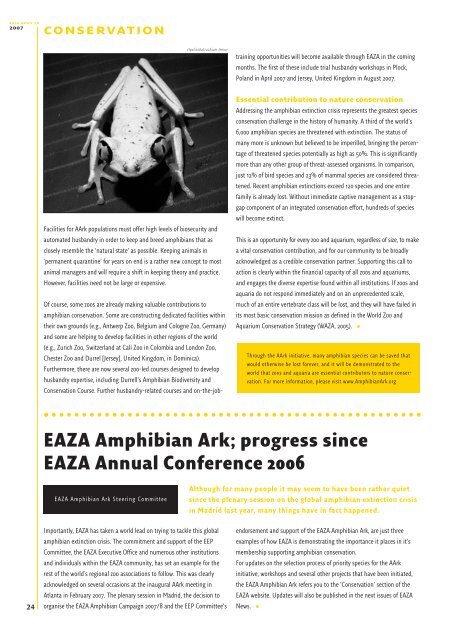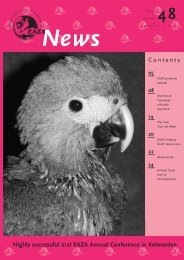EAZA News 58-9 - European Association of Zoos and Aquaria
EAZA News 58-9 - European Association of Zoos and Aquaria
EAZA News 58-9 - European Association of Zoos and Aquaria
You also want an ePaper? Increase the reach of your titles
YUMPU automatically turns print PDFs into web optimized ePapers that Google loves.
eaza news <strong>58</strong><br />
2007 conservation<br />
24<br />
Hyalinobatrachium lemur<br />
Facilities for AArk populations must <strong>of</strong>fer high levels <strong>of</strong> biosecurity <strong>and</strong><br />
automated husb<strong>and</strong>ry in order to keep <strong>and</strong> breed amphibians that as<br />
closely resemble the ‘natural state’ as possible. Keeping animals in<br />
‘permanent quarantine’ for years on end is a rather new concept to most<br />
animal managers <strong>and</strong> will require a shift in keeping theory <strong>and</strong> practice.<br />
However, facilities need not be large or expensive.<br />
Of course, some zoos are already making valuable contributions to<br />
amphibian conservation. Some are constructing dedicated facilities within<br />
their own grounds (e.g., Antwerp Zoo, Belgium <strong>and</strong> Cologne Zoo, Germany)<br />
<strong>and</strong> some are helping to develop facilities in other regions <strong>of</strong> the world<br />
(e.g., Zurich Zoo, Switzerl<strong>and</strong> at Cali Zoo in Colombia <strong>and</strong> London Zoo,<br />
Chester Zoo <strong>and</strong> Durrel [Jersey], United Kingdom, in Dominica).<br />
Furthermore, there are now several zoo-led courses designed to develop<br />
husb<strong>and</strong>ry expertise, including Durrell’s Amphibian Biodiversity <strong>and</strong><br />
Conservation Course. Further husb<strong>and</strong>ry-related courses <strong>and</strong> on-the-job-<br />
<strong>EAZA</strong> Amphibian Ark Steering Committee<br />
Importantly, <strong>EAZA</strong> has taken a world lead on trying to tackle this global<br />
amphibian extinction crisis. The commitment <strong>and</strong> support <strong>of</strong> the EEP<br />
Committee, the <strong>EAZA</strong> Executive Office <strong>and</strong> numerous other institutions<br />
<strong>and</strong> individuals within the <strong>EAZA</strong> community, has set an example for the<br />
rest <strong>of</strong> the world's regional zoo associations to follow. This was clearly<br />
acknowledged on several occasions at the inaugural AArk meeting in<br />
Atlanta in February 2007. The plenary session in Madrid, the decision to<br />
organise the <strong>EAZA</strong> Amphibian Campaign 2007/8 <strong>and</strong> the EEP Committee’s<br />
training opportunities will become available through <strong>EAZA</strong> in the coming<br />
months. The first <strong>of</strong> these include trial husb<strong>and</strong>ry workshops in Plock,<br />
Pol<strong>and</strong> in April 2007 <strong>and</strong> Jersey, United Kingdom in August 2007.<br />
Essential contribution to nature conservation<br />
Addressing the amphibian extinction crisis represents the greatest species<br />
conservation challenge in the history <strong>of</strong> humanity. A third <strong>of</strong> the world’s<br />
6,000 amphibian species are threatened with extinction. The status <strong>of</strong><br />
many more is unknown but believed to be imperilled, bringing the percentage<br />
<strong>of</strong> threatened species potentially as high as 50%. This is significantly<br />
more than any other group <strong>of</strong> threat-assessed organisms. In comparison,<br />
just 12% <strong>of</strong> bird species <strong>and</strong> 23% <strong>of</strong> mammal species are considered threatened.<br />
Recent amphibian extinctions exceed 120 species <strong>and</strong> one entire<br />
family is already lost. Without immediate captive management as a stopgap<br />
component <strong>of</strong> an integrated conservation effort, hundreds <strong>of</strong> species<br />
will become extinct.<br />
This is an opportunity for every zoo <strong>and</strong> aquarium, regardless <strong>of</strong> size, to make<br />
a vital conservation contribution, <strong>and</strong> for our community to be broadly<br />
acknowledged as a credible conservation partner. Supporting this call to<br />
action is clearly within the financial capacity <strong>of</strong> all zoos <strong>and</strong> aquariums,<br />
<strong>and</strong> engages the diverse expertise found within all institutions. If zoos <strong>and</strong><br />
aquaria do not respond immediately <strong>and</strong> on an unprecedented scale,<br />
much <strong>of</strong> an entire vertebrate class will be lost, <strong>and</strong> they will have failed in<br />
its most basic conservation mission as defined in the World Zoo <strong>and</strong><br />
Aquarium Conservation Strategy (WAZA, 2005). •<br />
Through the AArk initiative, many amphibian species can be saved that<br />
would otherwise be lost forever, <strong>and</strong> it will be demonstrated to the<br />
world that zoos <strong>and</strong> aquaria are essential contributors to nature conservation.<br />
For more information, please visit www.AmphibianArk.org<br />
<strong>EAZA</strong> Amphibian Ark; progress since<br />
<strong>EAZA</strong> Annual Conference 2006<br />
Although for many people it may seem to have been rather quiet<br />
since the plenary session on the global amphibian extinction crisis<br />
in Madrid last year, many things have in fact happened.<br />
endorsement <strong>and</strong> support <strong>of</strong> the <strong>EAZA</strong> Amphibian Ark, are just three<br />
examples <strong>of</strong> how <strong>EAZA</strong> is demonstrating the importance it places in it’s<br />
membership supporting amphibian conservation.<br />
For updates on the selection process <strong>of</strong> priority species for the AArk<br />
initiative, workshops <strong>and</strong> several other projects that have been initiated,<br />
the <strong>EAZA</strong> Amphibian Ark refers you to the ‘Conservation’ section <strong>of</strong> the<br />
<strong>EAZA</strong> website. Updates will also be published in the next issues <strong>of</strong> <strong>EAZA</strong><br />
<strong>News</strong>. •

















